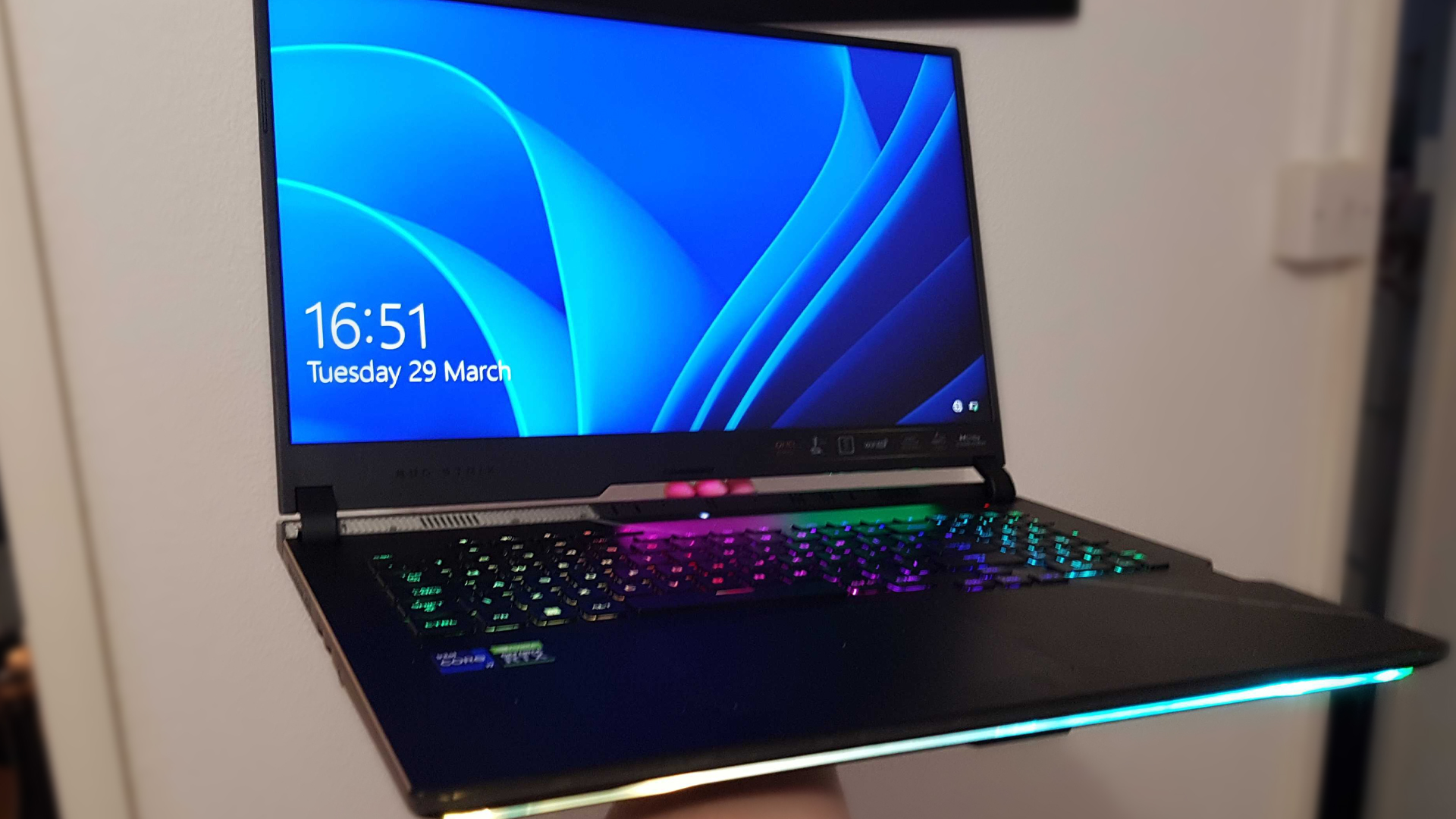Our Verdict
A well configured desktop replacement that's actually portable. While it only has an hour gaming time on battery, the 12th Gen Intel chip owns. That 150W RTX 3070 Ti means it kicks plenty of RTX 3080 powered laptops' butts, too.
For
- 150W RTX 3070 Ti performs above average
- 12th Gen Intel CPU is immense
- More DDR5 RAM than you probably need
- Speedy SSD performance
Against
- Prone to grease marks
- Gaming battery life is sorely lacking
PC Gamer's got your back
It's clear Asus is not messing around when it comes to the 2022 evolution of its high-end ROG gaming laptops. With the Strix Scar 17's G733Z configuration as my first taste—touting its masterful combination of Nvidia's new, more-powerful RTX 3070 Ti, and Intel's Core i9 12900H—that became very clear.
With a 12th Gen Alder Lake chip on its side, and a higher wattage GPU than some RTX 3080s we've spied in the wild, there's hardly an iota of competition for the price. But does the rest of the laptop stand up next to that immense config? I'd say yes, with a few small gripes.
First impressions: it's a gorgeous machine, but the chassis' finish collects grease marks super easily. Our Alan and Graeme aren't too keen on the smokey, translucent corner of the chassis, but the translucence does give the design a bit more flair. From the back, at least, it gives off a subtle enough gamer vibe that you could happily use it in the office, without looking like you're sneaking in a round of LoL.
The big ROG logo with RGB lighting is a bit of a giveaway, but you can turn the lighting effects off for a more subtle look.
Usually with these high-end laptops subtlety goes out of the window thanks to the tell-tale fan whine it gives out under load. This laptop, though: surprisingly quiet. It's blustery, but there's no high pitched noise to upset those without one of the best gaming headset protecting their ears. Not while it's in silent mode, anyhow.





Sadly, the cooling system doesn't translate into as fantastic temperatures as I'd have liked. Even unobstructed on my work desk, the GPU topped out at 87°C (189°F), while the CPU hit 100°C (212°F) over a day's gaming. While that's within spec, it's at the worrying end of okay.
If you're willing to risk the heat, though, here's what this Alder Lake beastie can do:




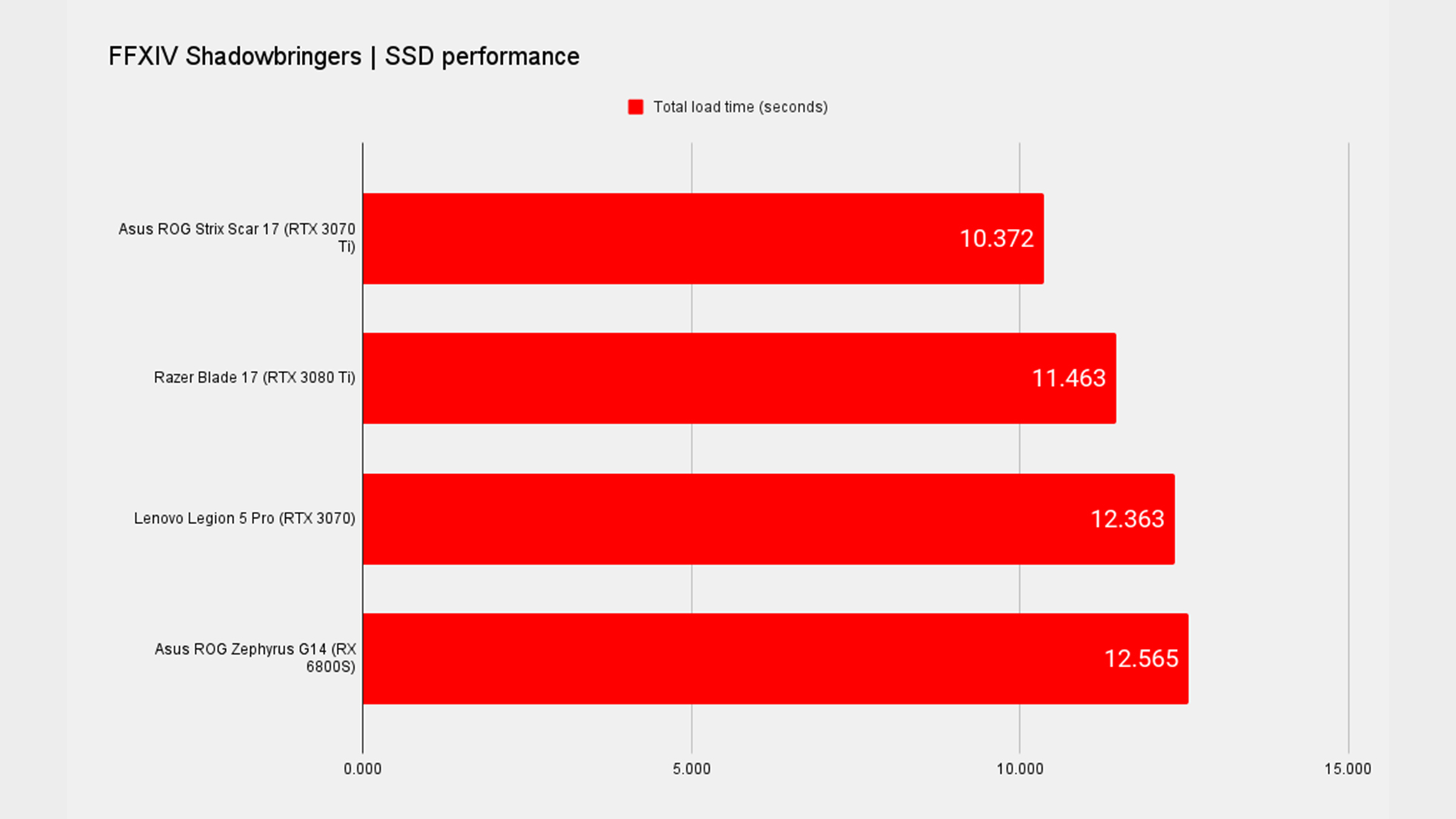


We've not had a chance to check out many 12th Gen gaming laptops, but seeing this one pitted against previous CPU generations, the difference is obvious.
The ROG Strix Scar 17's x264 video encoding scores are not to be trifled with, and it's up a good 600 points against the Razer Blade 17's Core i7 12800H when it comes to multi-core performance in Cinebench rendering tests. It also has around 1,800–2,000 points on the ROG Zephyrus G14's Ryzen 9 6900HS, and Lenovo Legion Pro's Ryzen 7 5800H's multi-core scores, respectively.
As for single core, the Scar manages to best the closest contender—the Ryzen 9 6900HS—by 130-odd points. Impressive.
Processor: Intel Core i9 12900H
Graphics: Nvidia GeForce RTX 3070 Ti (150W)
Memory: 32GB LPDDR5-4800
Display: 17.3-inch IPS, 240Hz, 3ms
Resolution: 1440p
Storage: 2TB M.2 SSD
Battery: 90Wh
Connectivity: 1x 3.5mm Combo Audio Jack, 1x HDMI 2.1, 2x USB 3.2 Gen 1 Type-A, 1x USB 3.2 Gen 2 Type-C support DisplayPort, 1x 2.5Gb LAN port, 1x Thunderbolt 4 DisplayPort, Bluetooth 5.2, Wi-Fi 6E
OS: Windows 11 Pro
Dimensions: 15.5 x 11.1 x 0.9in (395 x 282 x 234mm)
Weight: 6.39lbs (2.90Kg)
Price: $2,999 | £2,600
All this gives the Strix Scar 17 an edge when it comes to productivity and, of course, games with intense CPU loads. In Hitman's Dartmoor benchmark, for instance, you're looking at fps averages of 120, and lows of 23 even with all those particle effects going off.
Metro Exodus, too, sees lows of 47fps and 82fps averages. And while that's not quite as impressive as the Blade's RTX 3080 Ti, that 150-Watt RTX 3070 Ti really kicks butt. Even compared to some portable RTX 3080 SKUs we've tested—the MSI GS66 Stealth's 95W RTX 3080 for example—it's chugging out 167fps in F1 2020, and 113fps in Horizon Zero Dawn proves that this is a gaming powerhouse. It's certainly a vast improvement over the previous generation's 130W limit.
Topping it all off, the ROG Strix Scar 17's ray tracing performance is right where you'd expect it to be: sitting between the portable RTX 3080 Ti and RTX 3070, and miles above any AMD GPU config. Keep in mind that we tend to run our benchmarks on Ultra graphics settings and at 1080p resolution for comparisons—so not the laptop's native 1440p.
At 1440p you can expect scores to slip below the 100fps mark, but not enough to warrant turning the graphics down in most cases.


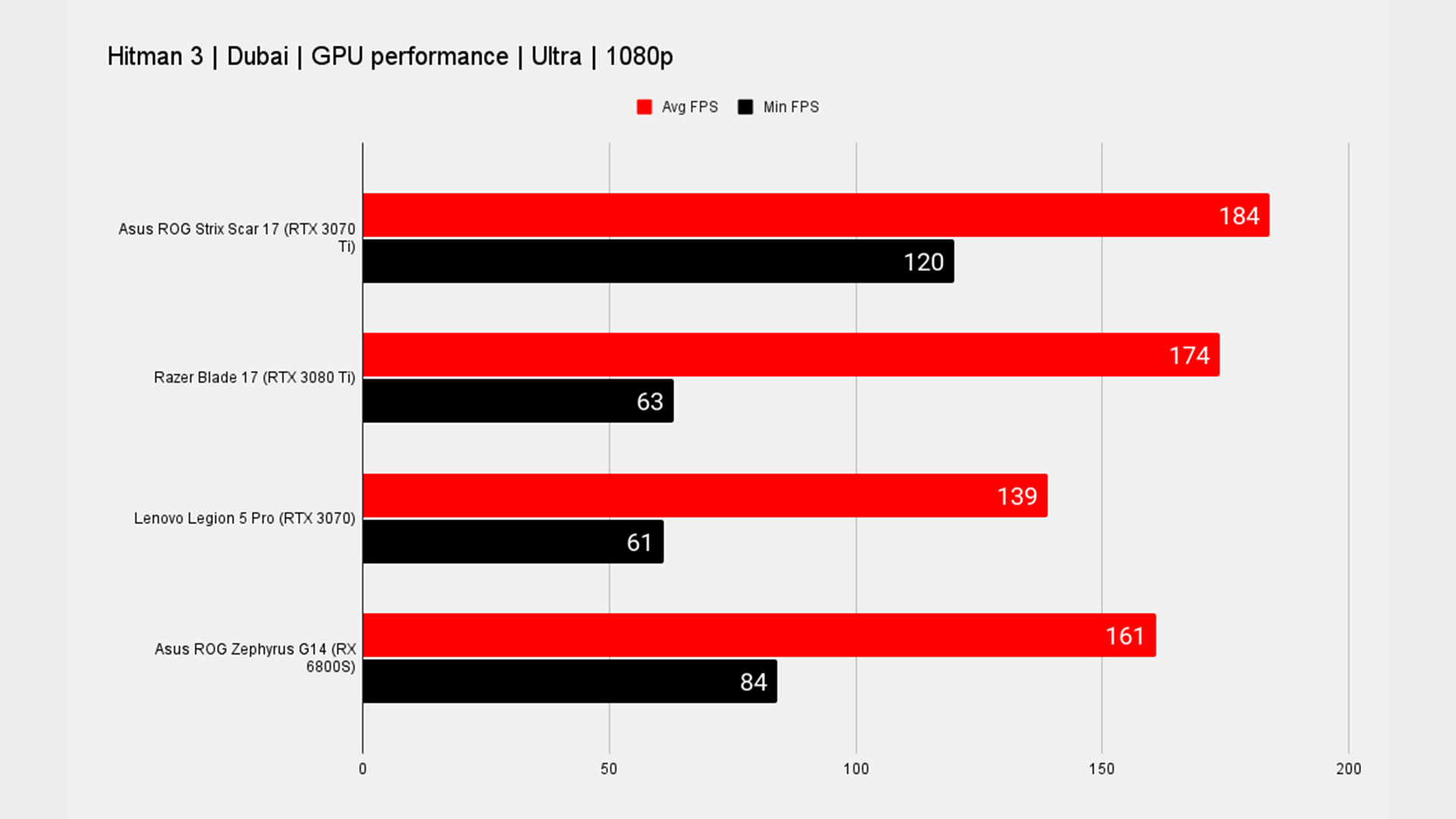


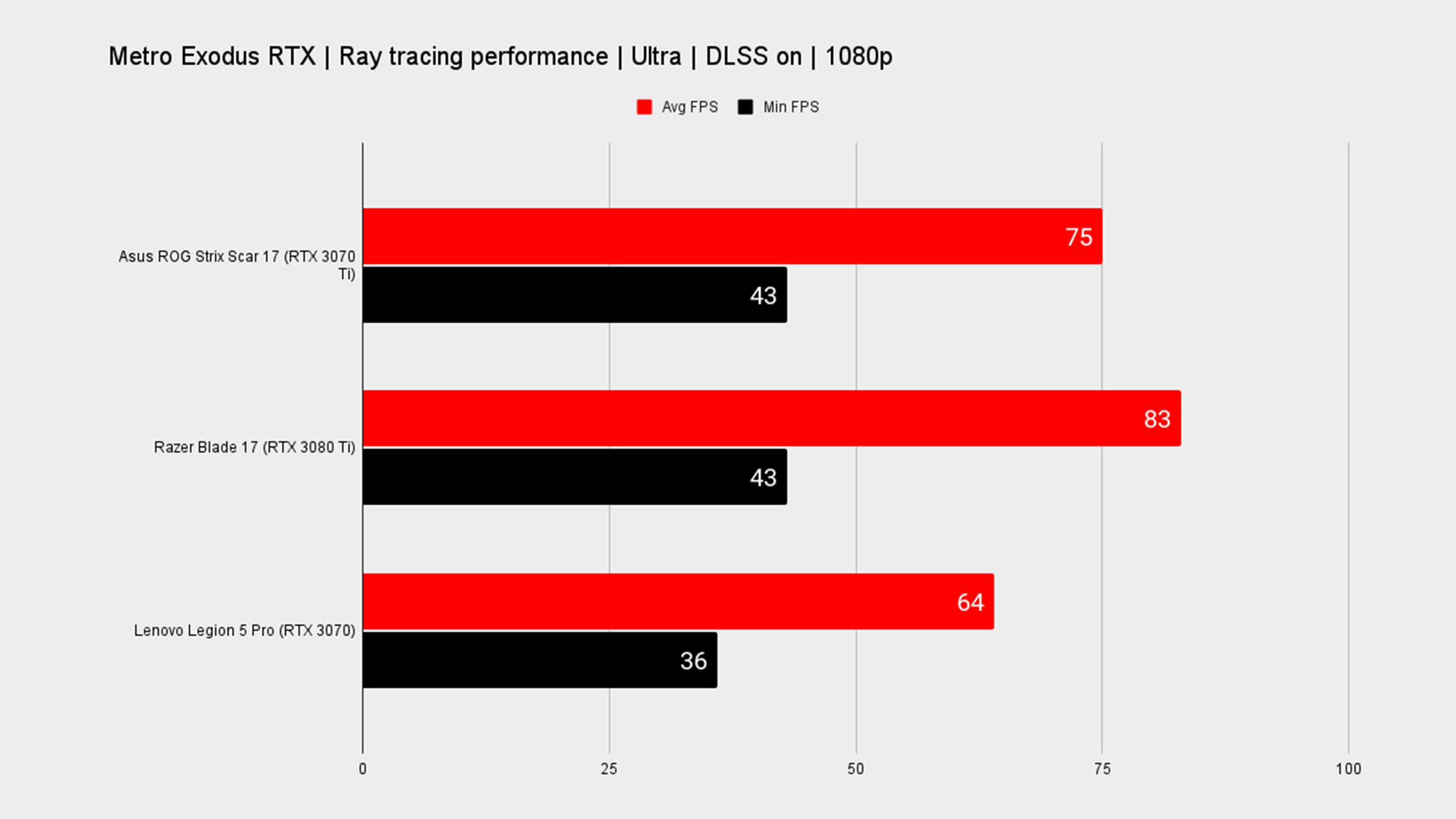
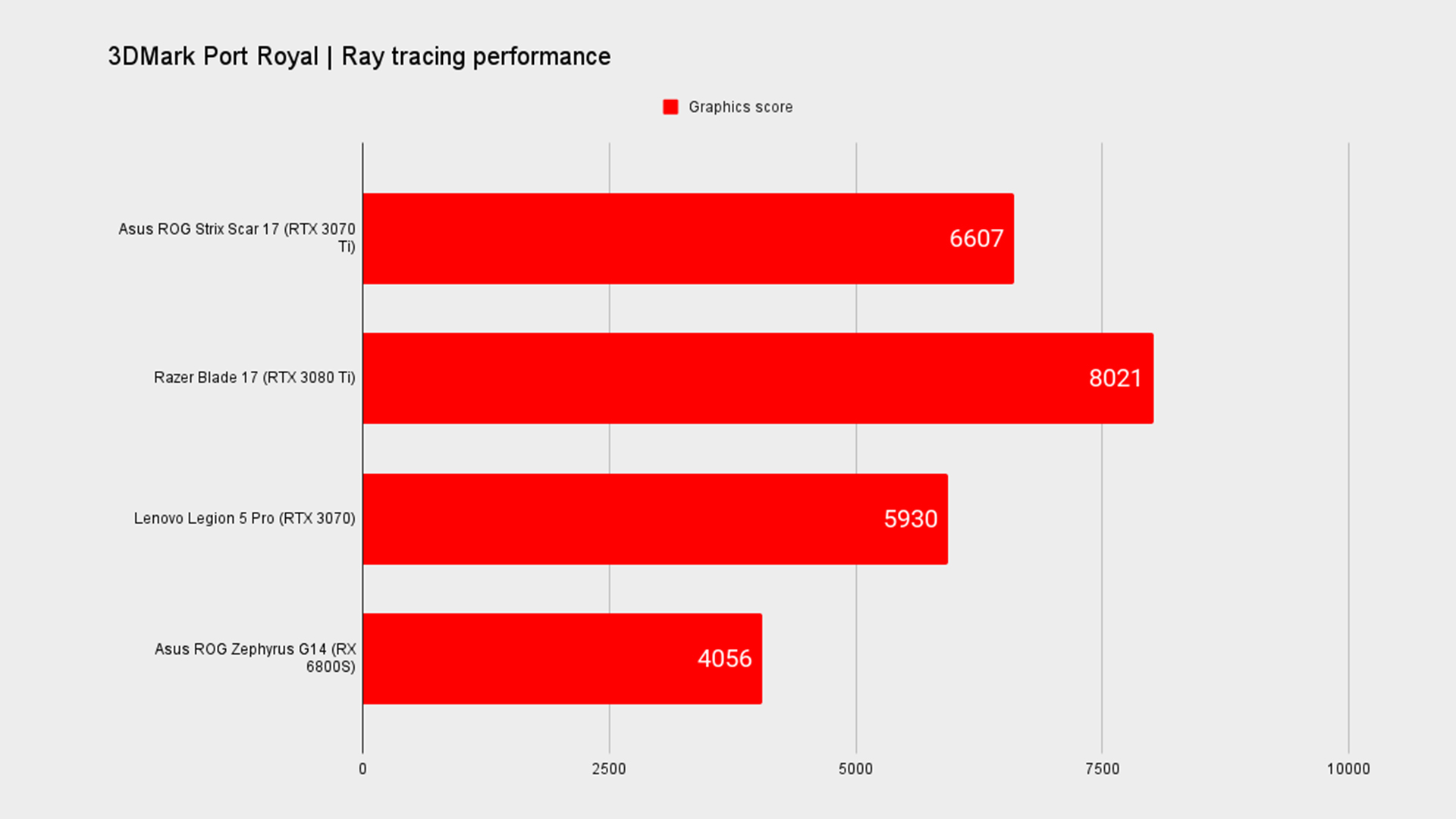
Importantly, all this power comes at a cost not only to the component's temperatures, but also to the battery life. Sure, you're not as likely to play games with the thing unplugged, but if you ever have to, an hour is all you get.
I'm not enamoured with the touchpad of the Strix Scar either, while we're nit-picking. I keep trying to click the space beneath it, and my poor, callous fingers keep forgetting where the edges are.
This particular model doesn't come with a camera either, which is a glaring omission for the price, and there's a distinct lack of USB Type-A ports for the unnecessary arsenal of peripherals I'm packing.
It doesn't feel as much like a hulking desktop replacement as we've seen. And that's okay.
There are a couple of USB Type-C ports around the back to make up for it, though, and I'm happy there's a full sized keyboard. Such gripes as I've mentioned are easy to overlook when Asus has managed to pack such an immense config in here. The frankly unnecessary 32GB of DDR5-4800 RAM's memory bandwidth sits at an impressive 53.27GB/s, and that 2TB SSD can load FFXIV Shadowbringers in just over 10 seconds, which is a solid score.
For a machine with a 17-inch chassis it doesn't weigh the world, and doesn't need two power adapters to work to its full potential either. For that, it doesn't feel as much like a hulking desktop replacement as we've seen. And that's okay. Particularly when you crown a portable machine like this off with a 1440p, 240Hz IPS panel with 3ms response time, which also does a smashing job of reducing glare.
While you could get a Lenovo Legion 5 Pro with its RTX 3070 for half the price, spending $2,999 (£2,600) on this Strix Scar config will put you ahead of the competition with very little effort. And sure, it's not as stylish or as apt with ray tracing as the Blade 17, but there's a good $1,000 price difference there. And for something that can outpace the laptops of yesteryear in almost every running, I'd pay that price for sure.
A well configured desktop replacement that's actually portable. While it only has an hour gaming time on battery, the 12th Gen Intel chip owns. That 150W RTX 3070 Ti means it kicks plenty of RTX 3080 powered laptops' butts, too.

Screw sports, Katie would rather watch Intel, AMD and Nvidia go at it. Having been obsessed with computers and graphics for three long decades, she took Game Art and Design up to Masters level at uni, and has been rambling about games, tech and science—rather sarcastically—for four years since. She can be found admiring technological advancements, scrambling for scintillating Raspberry Pi projects, preaching cybersecurity awareness, sighing over semiconductors, and gawping at the latest GPU upgrades. Right now she's waiting patiently for her chance to upload her consciousness into the cloud.
